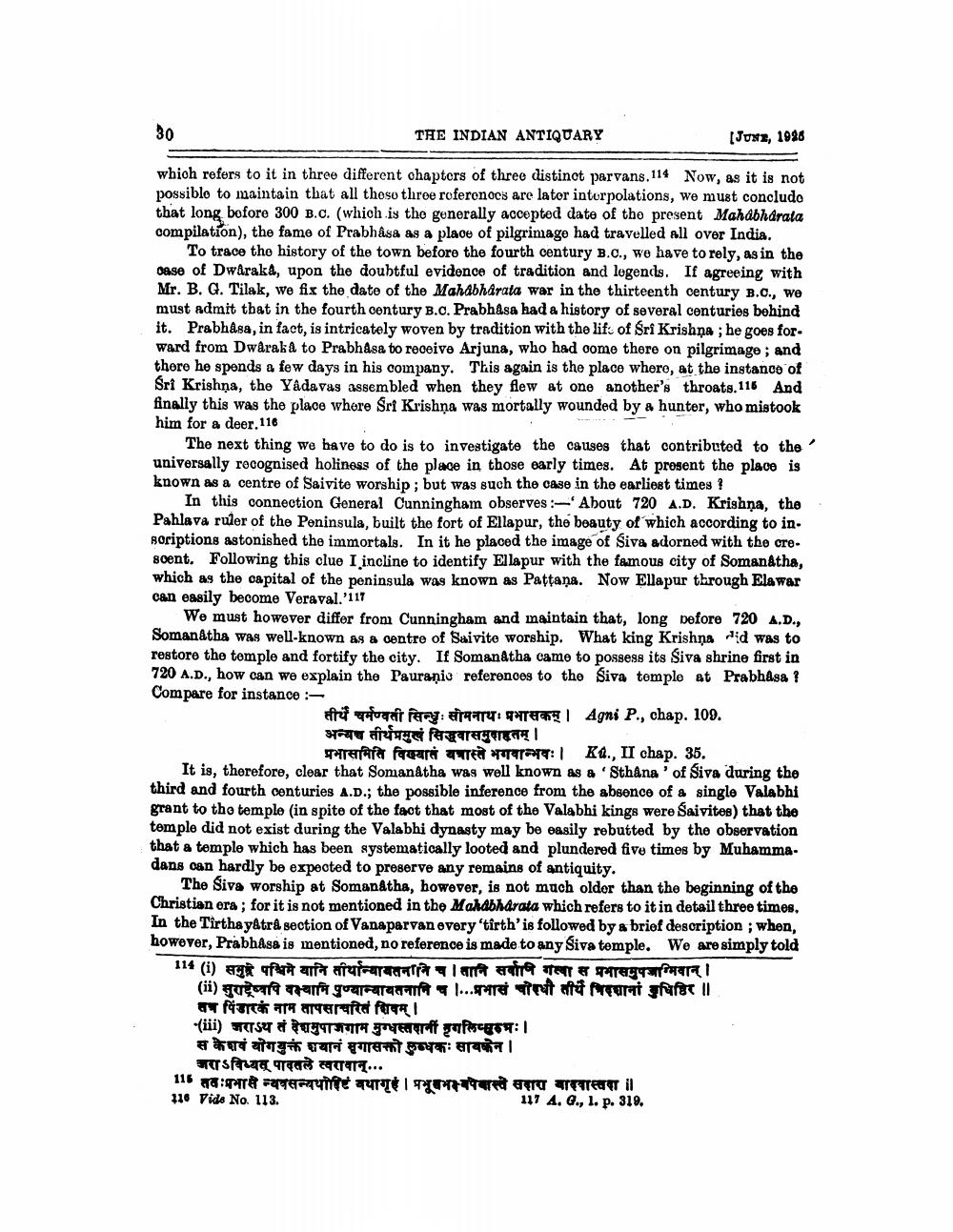________________
30
THE INDIAN ANTIQUARY
(June, 1996
which refers to it in three different chapters of three distinot parvans. 114 Now, as it is not possible to maintain that all those three roferenocs are later interpolations, we must concludo that long before 300 B.C. (which is the generally accepted date of the present Mahabharata compilation), the fame of Prabhâs& as a place of pilgrimage had travelled all over India.
To trace the history of the town before the fourth century B.C., we have to rely, as in the base of Dwaraka, upon the doubtful evidence of tradition and legends. If agreeing with Mr. B. G. Tilak, we fix the date of the Mahabharata war in the thirteenth century B.C., we must admit that in the fourth contury B.o. Prabhasa had a history of several centuries behind it. Prabhasa, in fact, is intricately woven by tradition with the lifs of Sri Krishna ; he goes for. ward from Dwaraka to Prabhasa to receive Arjuna, who had come there on pilgrimage ; and thore he spends a few days in his company. This again is the place whero, at the instance of Sri Krishna, the Yadavas assembled when they flew at one another's throats.116 And finally this was the place whore Sri Krishna was mortally wounded by a hunter, who mistook him for a deer. 116
The next thing we have to do is to investigate the causes that contributed to the universally recognised holiness of the place in those early times. At present the place is known as a centre of Saivite worship; but was such the case in the earliest times ?
In this connection General Cunningham observes - About 720 A.D. Krishna, the Pahlava ruler of the Peninsula, built the fort of Ellapur, the beauty of which according to in. Boriptions astonished the immortals. In it he placed the image of Siva adorned with the cresoent. Following this clue I incline to identify Ellapur with the famous city of Somanátha, which as the capital of the peninsula was known as Pattana. Now Ellapur through Elawar can easily become Veraval.'117
We must however differ from Cunningham and maintain that, long before 720 A.D., Somanåtha was well-known as a centre of Saivite worship. What king Krishna Mid was to restore the tomple and fortify the city. If Somanatha came to possess its Siva shrine first in 720 A.D., how can we explain the Pauranio references to the Siva temple at Prabhasa ? Compare for instance
eru varefter eraar: 19 Agni P., chap. 109.
अन्यच तीर्थप्रमुखं सिद्धवासमुशहतम् ।
T ara facer UMTET : KA., II chap. 35. It is, therefore, clear that Somanátha was well known as a 'Sthana' of Siva during the third and fourth centuries A.D.; the possible inference from the absence of a single Valabhi grant to the temple (in spite of the fact that most of the Valabhi kings were Saivites) that the temple did not exist during the Valabhi dynasty may be easily rebutted by the observation that a temple which has been systematically looted and plundered five times by Muhammadans oan hardly be expected to preserve any remains of antiquity.
The Siva worship at Somanátha, however, is not much older than the beginning of the Christian era ; for it is not mentioned in the Mahabharata which refers to it in detail three times, In the Tirthay&tra section of Vanaparvan every 'tîrth'is followed by a brief description ; when, however, Prabhåsa is mentioned, no reference is made to any Siva temple. We are simply told 114 (i) समुझे पश्चिम यानि तीर्थान्यायतनानि चवानि सर्वाणि गत्वा स प्रभासमुपजाग्मिवान् ।
(ii) get a gozar l... Tinatarrarat graet Il वत्र पिंडारकं नाम तापसाचरितं शिवम्।। (iii) जराऽथ तं देशमुपाजगाम मुग्धस्तानी गलिप्पुरुषः। स केशवं योगयुक्तं शयानं सुगासक्तो कुब्धका सावकेन ।
Sporta de ... 116 : ayeun TUTTO I
T
r ang TTTTEET il 110 Vide No. 113.
117 4. G., 1. p. 319.




